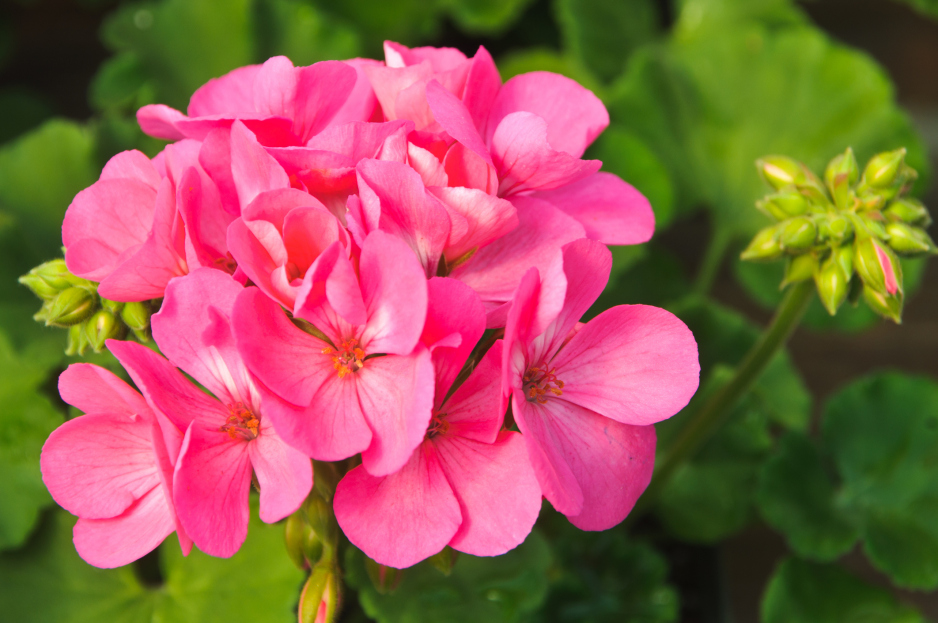
Geraniums (Pelargonium) are vibrant, colorful houseplants that bring a touch of cheer to any space. Known for their fragrant flowers and attractive foliage, geraniums are a popular choice for both indoor and outdoor gardens. Although they are often grown outdoors, geraniums can thrive indoors with the right care. Whether you're growing them in pots, hanging baskets, or window boxes, here's everything you need to know about caring for geranium houseplants.
Geraniums are sun-loving plants that thrive in bright, direct sunlight. For the best results, place your geranium in a sunny spot where it can receive at least 4-6 hours of direct sunlight each day. A south- or west-facing window is ideal for providing the right amount of light. If your geranium doesn’t receive enough sunlight, it may become leggy, with fewer blooms and weaker growth.
If you don’t have access to a lot of natural sunlight, you can supplement with grow lights to ensure your geranium gets the light it needs. Be mindful, however, that too much direct sunlight can cause the leaves to scorch, so it's important to find a balance.
Geraniums prefer to dry out between waterings, so it's important not to overwater them. Let the top inch or two of soil dry out before watering again. When you do water, make sure to water thoroughly until water drains from the bottom of the pot. This ensures that the roots receive adequate moisture without becoming waterlogged.
During the growing season (spring and summer), geraniums may need more frequent watering, especially if the plant is actively blooming. In the winter months, when the plant is dormant or growing more slowly, reduce watering to avoid overwatering. Always ensure that the pot has good drainage to prevent standing water at the bottom, which can lead to root rot.
Geraniums thrive in warm temperatures between 65°F and 75°F (18°C to 24°C). They can tolerate higher temperatures as long as they are not exposed to extreme heat or drafts. Avoid placing geraniums near air conditioning units, heaters, or vents, as sudden temperature changes can stress the plant.
Geraniums are relatively adaptable to average humidity levels, but they do appreciate slightly higher humidity. If your home is particularly dry, you can increase humidity by placing a humidity tray beneath the plant or using a room humidifier. However, geraniums are generally more tolerant of dry air than some other houseplants.
Geraniums prefer well-draining soil that retains moisture without becoming soggy. A general-purpose potting mix with added perlite or sand for drainage is ideal. Make sure the pot you choose has drainage holes to allow excess water to escape and prevent root rot.
If your geranium has outgrown its pot, you may need to repot it every 1-2 years. Choose a slightly larger pot and refresh the soil to encourage healthy growth. Repotting is best done in the spring, just before the growing season begins.
Geraniums benefit from regular feeding during the growing season. Use a balanced, water-soluble fertilizer to feed your plant every 4-6 weeks during spring and summer. You can switch to a fertilizer with higher phosphorus content to encourage more blooms. In the fall and winter, reduce fertilizing, as the plant is not actively growing.
Over-fertilizing can cause leggy growth or fewer blooms, so it’s better to under-fertilize than overdo it. Always follow the recommended dilution instructions on the fertilizer packaging.
To keep your geranium looking neat and encourage more blooms, regular pruning and deadheading are important. Deadheading is the process of removing spent flowers to prevent the plant from focusing energy on seed production. This encourages new flowers to grow. Use sharp, clean scissors or pruning shears to remove dead flowers, cutting just above the leaf node.
Pruning can also help control the size and shape of the plant. Trim back any leggy or overgrown stems to encourage bushier growth. If the plant becomes too large or unruly, you can prune it back in the spring to promote fresh growth.
Geraniums are relatively pest-resistant, but they can occasionally fall victim to common houseplant pests like aphids, spider mites, and whiteflies. If you notice any pests on your geranium, treat the plant with insecticidal soap or neem oil. Be sure to follow the product instructions carefully to avoid harming the plant.
Geraniums are also susceptible to fungal diseases, particularly if they are overwatered or have poor air circulation. To prevent fungal infections, avoid overhead watering and ensure that the plant has good drainage. If you notice any signs of disease, such as yellowing leaves or mold, remove the affected parts of the plant and treat it with a fungicide if necessary.
Geraniums are generally considered non-toxic to pets, making them safe for homes with cats and dogs. However, it's still a good idea to prevent pets from chewing on the plant, as ingesting large quantities could cause mild digestive upset. Always monitor your pets around plants, especially if they tend to nibble on greenery.